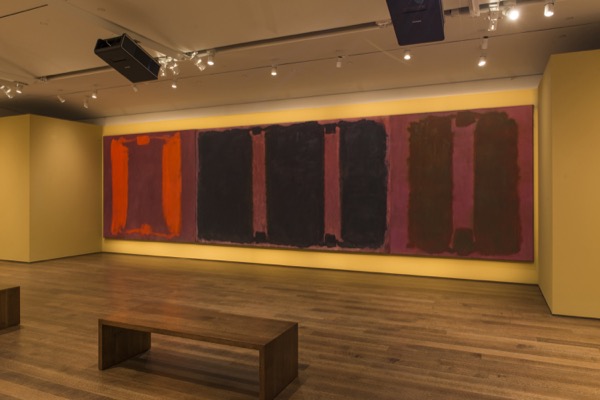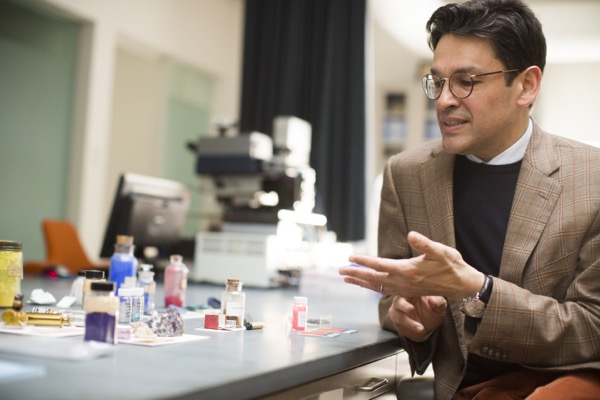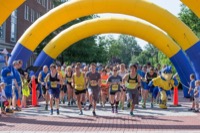


April 23: Art brought to light
Conservator to discuss pioneering work with Mark Rothko's Harvard Murals
1:22 p.m., April 18, 2016--Narayan Khandekar, the conservation scientist whose team used an innovative system of light projection to restore the appearance of a faded set of murals by Mark Rothko, will speak at the University of Delaware at 4 p.m., Saturday, April 23, in the Trabant University Center Theatre.
The talk, “Mark Rothko’s Harvard Murals: An Image for a Public Space,” is free and open to the public. It is being presented in conjunction with RED, a play about Rothko being performed on campus through May 8 by UD’s Resident Ensemble Players (REP).
Events Stories
June 5: Blue Hen 5K
June 6-9: Food and culture series
The five Harvard Murals were painted in 1962 by master abstract expressionist Rothko and were installed in a penthouse dining room of Harvard’s Holyoke Center in 1964. Over the years, the type of red pigment used and its exposure to natural light from the room’s large windows caused the colors to fade, and the paintings were put into storage in 1979.
“As conservators, we’re bedeviled when artists use materials that fade,” said Joyce Hill Stoner, an internationally known paintings conservator and the Edward F. and Elizabeth Goodman Rosenberg Professor in Material Culture
at UD.
In the case of the Harvard Murals, for example, “hot pink had faded to beige, but the original color could be detected” in the narrow strips that had been protected by the paintings’ frames, Stoner said. But painting over the works to restore the original colors would be categorically unethical, she said, so another solution was needed to create a display that would show visitors what the murals originally looked like.
A team of art historians, conservators and conservation scientists, including Khandekar, from research centers at the Harvard Art Museums and from the MIT Media Lab came up with a completely new approach. Using a camera-projector system with custom-made software the team developed, the murals went on display in 2014 illuminated by projected light that matched the original color, pixel by pixel.
The projectors were turned on each day while the murals were on exhibit and then turned off at the end of the day, when the colors again were shown in their current, faded appearance.
“It’s really an amazing story,” Stoner said of the novel and noninvasive approach. “We may see it done with other works in the future.”
Khandekar has called the project “an extremely rare opportunity to be able to research and develop a conservation tool that presents a new solution for an old problem.”
“The beauty of this digital technique is that it preserves the subtle and delicate surfaces of Rothko’s paintings, while still being fully reversible,” he said.
About the REP’s production of ‘RED’
The REP is performing RED, winner of the 2010 Tony Award for Best Play, at UD’s Roselle Center for the Arts through May 8.
The drama paints a portrait of Rothko as he works on the biggest commission in the history of modern art, a series of massive murals for New York’s Four Seasons restaurant, even as his assistant challenges his artistic integrity. Khandekar’s talk is designed to offer RED audiences new insights.
“We are very grateful to the Department of Art Conservation for arranging this lecture in conjunction with the REP’s production of RED,” said Sanford Robbins, chairperson of UD’s Department of Theatre. “The work Dr. Khandekar has done with the Rothko murals is fascinating and we are delighted that he will be sharing his experiences with our patrons.”
Stoner, who saw RED on Broadway, said the performance and the lecture are complementary. “The play is about the personality of Rothko, but the talk is about the process of conservation, which is a fascinating story itself,” she said.
About Narayan Khandekar
Khandekar is the director of the Straus Center for Conservation and Technical Studies, director of the Center for the Technical Study of Modern Art and head of the Analytical Laboratory, Harvard Art Museums.
He earned a doctoral degree in organic chemistry from the University of Melbourne and a postgraduate diploma in the conservation of easel paintings from the Courtauld Institute of Art, University of London.
Khandkekar is an author on more than 50 publications and one of the few conservator/conservation scientists asked to present a Ted talk on his work.
His talk at UD is sponsored by the Department of Art Conservation.
Article by Ann Manser
Photo by Peter Vanderwarker, courtesy of the President and Fellows of Harvard College; painting copyright 2014 Kate Rothko Prizel and Christopher Rothko/Artists Rights Society (ARS), New York.









